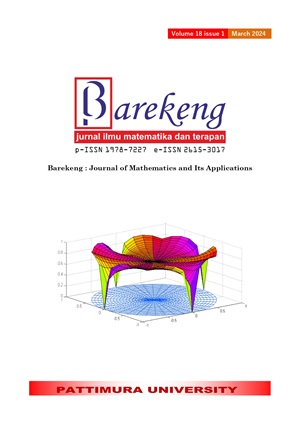IMPLEMENTATION OF THE BIDIRECTIONAL GATED RECURRENT UNIT ALGORITHM ON CONSUMER PRICE INDEX DATA IN INDONESIA
Abstract
The Consumer Price Index (CPI) is the main index in measuring the inflation rate. Changes in the CPI from time to time reflect inflation and deflation, namely the higher the CPI value, the higher the inflation rate. This study aims to apply Birectional Gated Recurrent Unit (BiGRU) model to the CPI data in Indonesia. BiGRU comprises two GRU layers so it captures sequences that are ignored by the GRU. The research data is in the form of CPI data in Indonesia from January 2006 to December 2022 sourced from the website of the Central Bureau of Statistics totaling 204 data. The data is divided into training data and testing data. Training data was taken from January 2006 to July 2019 as many as 163 data. Data testing was taken from August 2019 to December 2022 as many as 41 data. Before the data is processed, a sliding window process is carried out by dividing the data into segments to reduce the error value. The window size value used is 10. In the sliding window process, the number of segments is 194 data segments. Based on the experiment results, it was concluded that the application of BiGRU to the CPI data was carried out in an experiment with 20 BiGRU architectures. BiGRU architecture was obtained which produced the lowest MAPE value, namely an architecture with two BiGRU layers having 256 neurons and 400 units, and one dense layer. In addition, the epochs used are 200 epochs, the ReLU activation function, and Adam optimization. The experimental results of the BiGRU architecture obtained a MAPE value of 0.24% which indicates that the architectural performance is very good.
Downloads
References
E. Riyanto, “Peramalan Harga Saham Menggunakan Jaringan Syaraf Tiruan Secara Supervised Learning Dengan Algoritma Backpropagation,” J. Inform. Upgris, vol. 3, no. 2, pp. 137–142, 2017, doi: 10.26877/jiu.v3i2.1899.
F. W. Zhang, W. G. Che, B. B. Xu, and J. Z. Xu, “The research of ARMA model in CPI time series,” Appl. Mech. Mater., vol. 347–350, pp. 3099–3103, 2013, doi: 10.4028/www.scientific.net/AMM.347-350.3099.
F. Meng, T. Song, D. Xu, P. Xie, and Y. Li, “Forecasting tropical cyclones wave height using bidirectional gated recurrent unit,” Ocean Eng., vol. 234, no. January, p. 108795, 2021, doi: 10.1016/j.oceaneng.2021.108795.
D. She and M. Jia, “A BiGRU method for remaining useful life prediction of machinery,” Meas. J. Int. Meas. Confed., vol. 167, no. July 2020, p. 108277, 2021, doi: 10.1016/j.measurement.2020.108277.
S. Dogani, J., Farshad, K., Mehdi, “Host Load Prediction in Cloud Computing with Discrete Wavelete Transformation (DWT) and Bidirectional Gated Recurrent Unit (BiGRU) Network,” vol. 198, pp. 157–174, 2022.
Badan Pusat Statistik, “Indeks Harga Konsumen dan Inflasi Bulanan Indonesia, 2006-2022.” https://www.bps.go.id/statictable/2009/06/15/907/indeks-harga-konsumen-dan-inflasi-bulanan-indonesia-2006-2022.html (accessed May 29, 2022).
J. Gama, R. Sebastião, and P. P. Rodrigues, “On evaluating stream learning algorithms,” Mach. Learn., vol. 90, no. 3, pp. 317–346, 2013, doi: 10.1007/s10994-012-5320-9.
D. E. Birba, “Study of Data Splitting Algorithms for Machine Learning,” 2020.
K. Cho et al., “Learning phrase representations using RNN encoder-decoder for statistical machine translation,” EMNLP 2014 - 2014 Conf. Empir. Methods Nat. Lang. Process. Proc. Conf., pp. 1724–1734, 2014, doi: 10.3115/v1/d14-1179.
D. Bahdanau, K. H. Cho, and Y. Bengio, “Neural machine translation by jointly learning to align and translate,” 3rd Int. Conf. Learn. Represent. ICLR 2015 - Conf. Track Proc., pp. 1–15, 2015.
J. Rosindell and Y. Wong, “Biodiversity, the tree of life, and science communication,” Phylogenetic Divers. Appl. Challenges Biodivers. Sci., no. 2, pp. 41–71, 2018, doi: 10.1007/978-3-319-93145-6_3.
J. Yuan and Y. Tian, “An intelligent fault diagnosis method using GRU neural network towards sequential data in dynamic processes,” Processes, vol. 7, no. 3, 2019, doi: 10.3390/pr7030152.
J. Chung, C. Gulcehre, K. Cho, and Y. Bengio, “Empirical Evaluation of Gated Recurrent Neural Networks on Sequence Modeling,” no. December, 2014, [Online]. Available: http://arxiv.org/abs/1412.3555
H. He, H. Wang, H. Ma, X. Liu, Y. Jia, and G. Gong, “Research on Short-term Power Load Forecasting Based on Bi-GRU,” J. Phys. Conf. Ser., vol. 1639, no. 1, 2020, doi: 10.1088/1742-6596/1639/1/012017.
A. De Myttenaere et al., “Mean Absolute Percentage Error for regression models To cite this version : HAL Id : hal-01312590,” Adv. Artif. neural networks, Mach. Learn. Comput. Intell. - Sel. Pap. from 23rd Eur. Symp. Artif. Neural Networks (ESANN 2015), pp. 38–48, 2017.
P. C. Chang, C. H. Liu, C. H. Yeh, and S. H. Chen, “The development of a weighted evolving fuzzy neural network,” Lect. Notes Comput. Sci. (including Subser. Lect. Notes Artif. Intell. Lect. Notes Bioinformatics), vol. 4114 LNAI, pp. 212–221, 2006, doi: 10.1007/978-3-540-37275-2_28.
Copyright (c) 2024 Andjani Ayu Cahaya Tanjung, Dewi Retno Sari Saputro, Nughthoh Arfawi Kurdhi

This work is licensed under a Creative Commons Attribution-ShareAlike 4.0 International License.
Authors who publish with this Journal agree to the following terms:
- Author retain copyright and grant the journal right of first publication with the work simultaneously licensed under a creative commons attribution license that allow others to share the work within an acknowledgement of the work’s authorship and initial publication of this journal.
- Authors are able to enter into separate, additional contractual arrangement for the non-exclusive distribution of the journal’s published version of the work (e.g. acknowledgement of its initial publication in this journal).
- Authors are permitted and encouraged to post their work online (e.g. in institutional repositories or on their websites) prior to and during the submission process, as it can lead to productive exchanges, as well as earlier and greater citation of published works.






1.gif)



